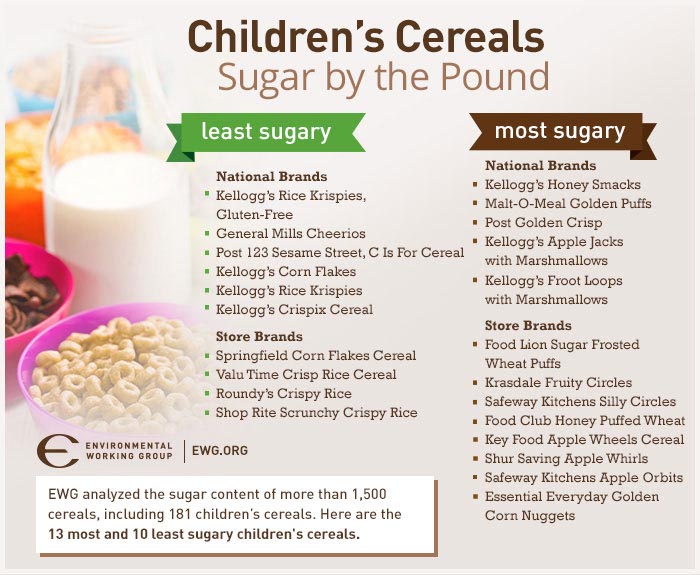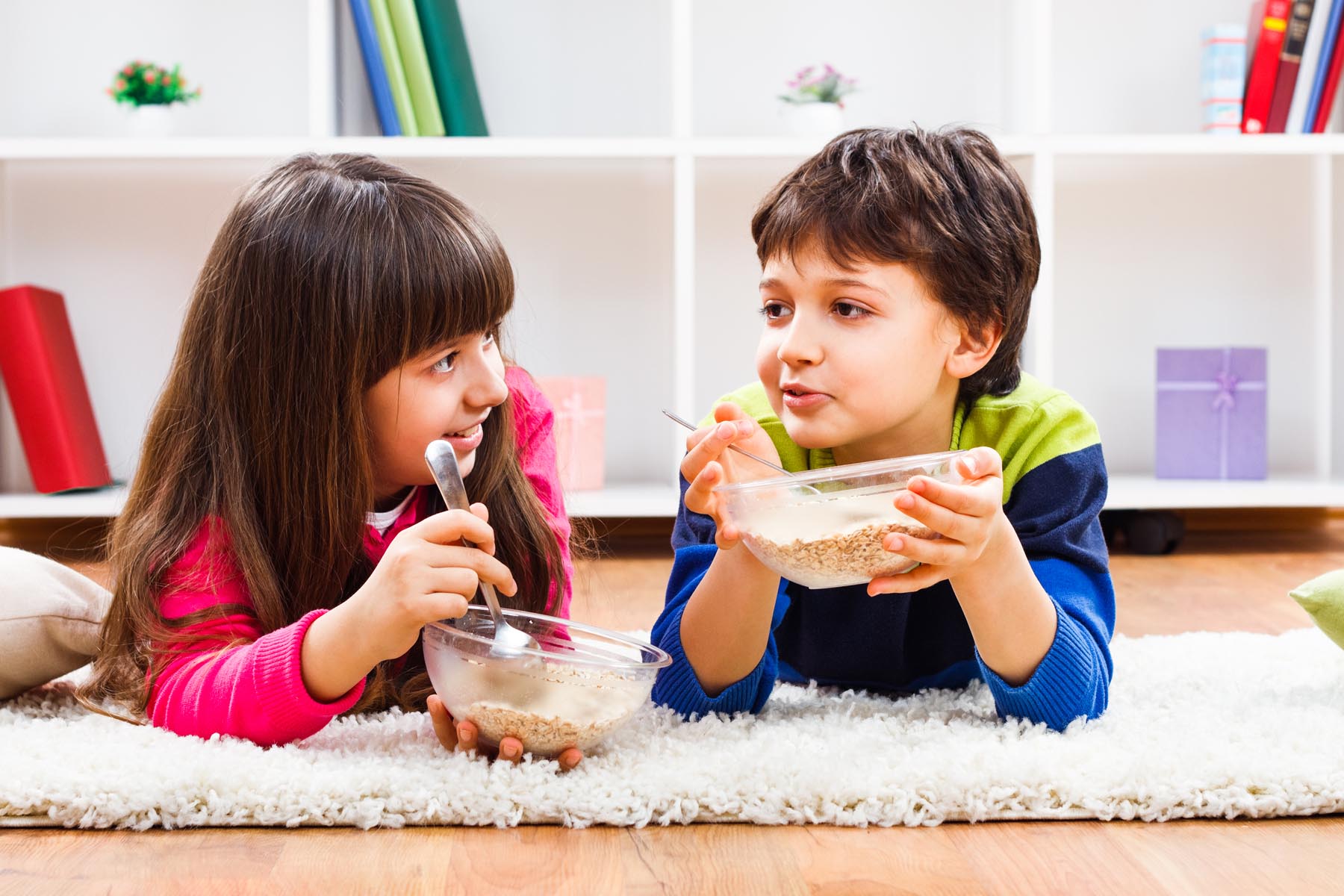It’s no wonder that cereals loaded with the most added sugar frequently come in packaging that features cartoon characters to appeal to kids. The manufacturers market to children with these iconic characters – Tony The Tiger, Cap’n Crunch, Count Chocula, Trix Rabbit, and let’s not forget Lucky Charm Leprechaun. Besides sugar, what are the other ingredients in the cereal your child (or you) are eating? Let’s look inside your child’s favorite box of cereal.
CEREAL – WHAT’S IN IT AND HOW IS IT MADE?
Sugar: Many childrens’ cereals are high in high fructose corn syrup (HFCS) or sugar, also known as corn syrup. The general rule is that if sugar is listed on the box, it highly likely it’s HFCS. A child who eats a bowl of cereal a day for a year ends up consuming 10 pounds of sugar. (See list below)
GMOs: Most traditional cereals contain sugar and corn made from Genetically Modified Organisms (GMO) products. Note: these cereal manufacturers create GMO free cereals for distribution to foreign countries due to their strict governmental regulation.
Hydrogenated Oils: Partially hydrogenated oils contain trans fats, which are linked to auto-immune diseases, heart disease, and cancer. Fully hydrogenated oils are full of saturated fat. Note that current labeling laws permit a manufacturer to state “0 grams” of trans fat if there is less than “0.5 grams” of trans fat per serving.
BHA: While listed as a Generally Recognized As Safe (GRAS) additive by the FDA, BHA has been linked to cancer in some studies. The National Institutes of Health’s (NIH) National Toxicology Programs has concluded that it can be “reasonably anticipated to be a human carcinogen.” The FDA stated that BHA and BHT are said to be at low enough levels to be safe for human consumption.
Soy Lecithin: Derived from GMO soy, this additive may contains toxins. According to The Cornucopia Institute, soy lecithin processing often involves hexane. Although it is removed in the processing, trace amounts can be left behind. That residue is not regulated by the FDA, even though it is listed as a potential carcinogen and neurotoxin.
Annatto: While being a natural flavoring, WebMD stated it can affect blood sugar levels. Annatto has been linked to allergies, and the Food Intolerance Network has received reports linking it to headaches and irritability.
BHT: Found in many cereals, this is another food classified by the FDA as GRAS. This means that experts consider BHT safe and it is approved as a food additive without additional testing of its effects. In 2014, the National Resources Defense Council (NRDC), an environmental safety watchdog group, released “Generally Recognized as Secret: Chemicals Added to Food in the U.S.” This report found loopholes in the GRAS classification, including research data coming from the company themselves and expert opinions that disregarded evidence of allergic reactions, that compromise the real safety of GRAS additives. BHT is also a chemical additive and may trigger Attention Deficit/Hyperactivity Disorder (ADHD).
Extrusion process: Many cereals are manufactured using an “extrusion process,” which exposes the cereal grains to high levels of heat and pressure, thereby changing the nature of the grain, and turning it into processed food. Biochemist Paul Stitt noted that extrusion process destroys most of the grains’ natural nutrients. This is why many cereals are “fortified,” although extrusion can destroy those added nutrients as well.
Fortified: Many cereals try to cover up their high sugar content with fortification, which adds back in nutrients. As mentioned above, extrusion can deplete these nutrients. Also, fortified foods may contain too many nutrients, which can be toxic for your child.
THE BAD CEREALS
Mamavation’s study of cereal’s “toxic ingredients” lists the top 10 cereals that children (and grown-ups) should avoid because they use extrusion processing, contain GMOs, and are fortified. Note: 4 grams is equivalent to 1 teaspoon.
- Fruit Loops: Hydrogenated or partially hydrogenated vegetable oil, annatto, BHT, artificial dyes including red #40, 12g of sugar.
- Fruit Loops with Marshmallows: Hydrogenated or partially hydrogenated vegetable oil, annatto, BHT, artificial dyes including red #40, 14g sugar.
- Corn Pops: Hydrogenated coconut and soybean oil, annatto, BHT, 9g of sugar.
- Apple Jacks: Partially hydrogenated vegetable oil, artificial dyes including red #40, BHT, 12g of sugar.
- Honey Smacks: Hydrogenated or partially hydrogenated vegetable oil, soy lecithin, BHT, 15g of sugar.
- Lucky Charms: Corn syrup, trisodium phosphate, artificial dyes including red #40, artificial flavor, 10g of sugar.
- Boo Berry/Count Chocula/Franken Berry: Sugar, dextrose and corn syrup, canola oil, BHT, trisodium phosphate, artificial dyes including red #40, artificial flavor, 9g of sugar.
- Trix: Corn syrup, BHT, trisodium phosphate, artificial dyes including red #40, 12g of sugar.
- Fruity Pebbles: Hydrogenated vegetable oil, artificial dyes including red #40, artificial flavor, BHA, 9g of sugar.
- Cap’n Crunch CrunchBerries: Artificial flavor, artificial dyes including red #40, BHT, 11g of sugar. Cap’n Crunch Oops! All Berries Cereal contains 15g of sugar.
- Golden Crisps: Sugar, corn syrup, 14g of sugar.
THE GOOD AND BAD CEREALS
EWG’s analysis of more than 1,500 cereals, including more than 180 kid’s cereals, shows that a child who eats a bowl a day for a year ends up consuming 10 pounds of sugar. Their survey also revealed that 11 of the 13 most heavily sugared children’s cereals feature marketing claims such as “Good Source of Fiber” that suggest misleadingly that the products are healthy.
So how do you navigate the grocery aisle to find the least sugary products? Check the list below to see which cereals have most and the least amount of sugar before you heading out. EWG recommends no more than 4 grams (1 teaspoon) of sugar per serving.

